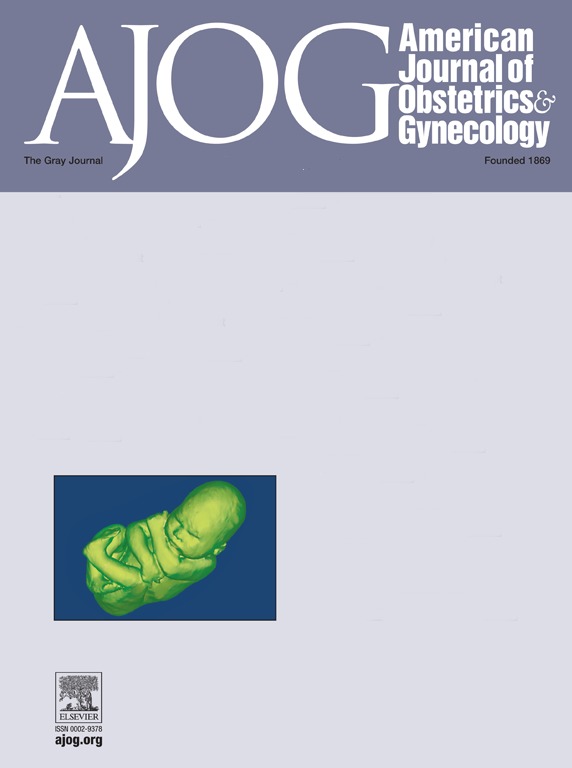诊断超声告知手术入路剖宫产的高风险患者胎盘增生谱系障碍。
IF 8.4
1区 医学
Q1 OBSTETRICS & GYNECOLOGY
引用次数: 0
摘要
背景:保留子宫内膜手术已成为胎盘增生谱系障碍患者的一种选择。决定进行剖宫产子宫切除术还是保留子宫手术是在术中做出的。本研究旨在评估超声标志物在预测子宫切除术中的价值。目的探讨有增生性胎盘谱危险的患者行剖宫产子宫切除术的超声指标。研究设计:对2023年9月至2024年8月期间前瞻性收集的高风险胎盘增生谱患者数据进行分析。超声检查由专家进行,重点诊断胎盘增生谱。所有患者均被告知本中心可用的治疗方案,即保留子宫手术和子宫切除术。如果安全且技术可行,所有患者均选择子宫保留手术。最终选择的手术处理方法是完全基于术中地形描述的大小和位置的异常粘附胎盘。主要结果是需要子宫切除术,尽管术前计划子宫保留手术。结果共纳入123例患者,其中胎盘增生谱93例,非胎盘增生瘢痕裂开30例。子宫保留手术在93例(79.6%)胎盘增生谱病例中有74例(79.6%)成功,非胎盘增生瘢痕裂开病例中100%成功。最小绝对收缩和选择算子惩罚回归显示,宫颈内血管充血50%,膀胱壁扭曲和参数性血管充血是子宫切除术最具影响力的预测因素。模型交叉验证后,最佳拟合模型的准确率达到94% (95% CI: 81.3% - 99.3%)。宫颈内血管增生50%合并膀胱壁变形对子宫切除术的预测概率最高,为0.87 (95% CI: 0.81 ~ 0.93),敏感性为96.0% (95% CI 89.0 ~ 99.0%),特异性为92.0%(95% CI 62.0 ~ 100.0)。结论术前综合超声可合理预测增生性胎盘的手术入路。这可以通过联合使用经腹、经阴道和彩色多普勒超声技术来评估宫颈内血管扩张和膀胱壁扭曲来实现,因为在打算进行子宫保留手术治疗的队列中,这些体征与需要子宫切除术有很强的相关性。本文章由计算机程序翻译,如有差异,请以英文原文为准。
Diagnostic ultrasound to inform the surgical approach to cesarean delivery in patients at high risk for placenta accreta spectrum disorders.
BACKGROUND
Uterine sparing surgery has become an option for patients with placenta accreta spectrum disorders. The decision to perform a cesarean hysterectomy versus uterine sparing surgery is made intraoperatively. This study was undertaken to assess the value of ultrasound markers in predicting hysterectomy.
OBJECTIVE
To describe ultrasound markers associated with the need for cesarean hysterectomy in patients at risk of placenta accreta spectrum.
STUDY DESIGN
This was an analysis of a prospectively collected data of high risk placenta accreta spectrum patients between September 2023 and August 2024. Ultrasound examination was performed by an expert focusing on the diagnosis of placenta accreta spectrum. All patients were counselled regarding the management options available at our center, namely uterine-sparing surgery and hysterectomy. All patients opted for a uterine sparing surgery if safe and technically feasible. The final choice of surgical management approach was solely based on the intraoperative topography which describes the size and location of the abnormally adhered placenta. The primary outcome was the need for hysterectomy despite a preoperative plan for uterine-sparing surgery.
RESULTS
A total of 123 participants were enrolled: 93 placenta accreta spectrum cases and 30 non-placenta accreta scar dehiscence cases. Uterine sparing surgery was successful in 74 out of 93(79.6%) placenta accreta spectrum cases and 100% non-placenta accreta scar dehiscence cases. Least Absolute Shrinkage and Selection Operator penalised regression revealed intracervical hypervascularity >50%, distorted urinary bladder wall, and parametrial hypervascularity as the most influential predictors for hysterectomy. This best-fitted model achieved accuracy of 94% (95% CI: 81.3% - 99.3%) after model cross-validation. The combination of intracervical hypervascularity >50% and distorted bladder wall had the highest predictive probability for hysterectomy, with a value of 0.87 (95% CI: 0.81 - 0.93), sensitivity of 96.0% (95% CI 89.0 - 99.0%) and specificity of 92.0%(95% CI 62.0 - 100.0).
CONCLUSION
Comprehensive preoperative ultrasound can reasonably predict the appropriate surgical approach to placenta accreta spectrum. This can be achieved by assessing intracervical hypervascularity and a distorted urinary bladder wall using a combination of transabdominal, transvaginal, and color Doppler ultrasound techniques, as these signs have a strong correlation with the need for hysterectomy in a cohort where the intention to treat was uterine sparing surgery.
求助全文
通过发布文献求助,成功后即可免费获取论文全文。
去求助
来源期刊
CiteScore
15.90
自引率
7.10%
发文量
2237
审稿时长
47 days
期刊介绍:
The American Journal of Obstetrics and Gynecology, known as "The Gray Journal," covers the entire spectrum of Obstetrics and Gynecology. It aims to publish original research (clinical and translational), reviews, opinions, video clips, podcasts, and interviews that contribute to understanding health and disease and have the potential to impact the practice of women's healthcare.
Focus Areas:
Diagnosis, Treatment, Prediction, and Prevention: The journal focuses on research related to the diagnosis, treatment, prediction, and prevention of obstetrical and gynecological disorders.
Biology of Reproduction: AJOG publishes work on the biology of reproduction, including studies on reproductive physiology and mechanisms of obstetrical and gynecological diseases.
Content Types:
Original Research: Clinical and translational research articles.
Reviews: Comprehensive reviews providing insights into various aspects of obstetrics and gynecology.
Opinions: Perspectives and opinions on important topics in the field.
Multimedia Content: Video clips, podcasts, and interviews.
Peer Review Process:
All submissions undergo a rigorous peer review process to ensure quality and relevance to the field of obstetrics and gynecology.

 求助内容:
求助内容: 应助结果提醒方式:
应助结果提醒方式:


